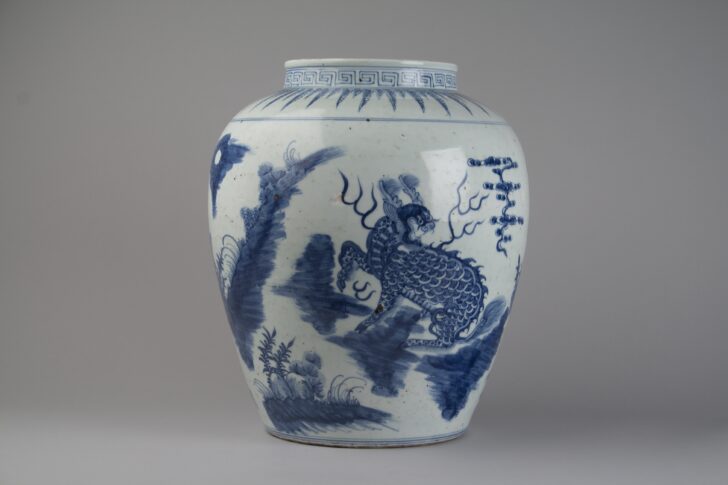Jar
Chinese

Description
Subject Matter:
A qinghua (清华) blue and white jar, guan (罐), of the Ming Dynasty (1368-1644).
Qilin (麒麟) are mythical zoomorphic beasts sometimes referred to as the Chinese unicorn, though they may have either one or two horns, lion heads, goat-like hooves, and scales all over their bodies. They are auspicious, peaceful creatures that offer protection and are thought to also bring good luck, prosperity, and success.
Lingzhi (灵芝) mushrooms are the Daoist mushrooms of immortality, and have been a staple of Chinese medicine for over 2000 years. Ruyi, or "as you wish" scepters, are based on the form of the lingzhi mushrooms. Both lingzhi and ruyi are auspicious symbols and often appear in Chinese ceramics in landscapes, meander, stylized clouds, or as patterned borders.
The discovery of kaolin clay at Jingdezhen, Jiangxi, led to the establishment of official kilns during the Yuan dynasty (1279-1368), and the production of pure, white, hard paste porcelain and porcelain decorated with underglaze blue. During the 13th century of the Yuan dynasty, with the establishment of Pax Mongolia, blue and white porcelains were exported to Europe and the Middle East, as both tribute gifts as well as for the overseas export market. This continued through the Ming dynasty, where porcelain was used domestically by all classes of society. A vast array of forms and designs were made to appeal to a large and diverse overseas, as well as, domestic market.
One of the most popular forms of decoration was underglaze cobalt blue. During the Yuan dynasty, the principal source of cobalt came from Persia. In the Ming, however, local sources were found. The domestic cobalt, high in manganese and iron, resulted in a deep blue color with dark specks that has become known as a “heap and piled” effect, a hallmark of Ming qinghua—blue and white—wares, that was imitated in the later Qing dynasty.
Physical Description:
This porcelain jar tapers to a base with a recessed foot ring, and has wide, softly rounded shoulders leading up to a wide neck. It is painted with underglaze cobalt blue to depict a key-fret border around the neck, with banana leaf lappets around the shoulder, and two qilin (麒麟) in a mountainous landscape with lingzhi-shaped clouds. It is covered in a clear glaze, and has an unmarked base.
Usage Rights:
If you are interested in using an image for a publication, please visit https://umma.umich.edu/request-image/ for more information and to fill out the online Image Rights and Reproductions Request Form.